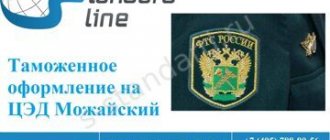Goods imported into Russia may either be subject to mandatory certification or declaration or not. In some cases, regulatory authorities may require documents (declarations, certificates, conclusions) confirming product compliance with regulatory requirements. A waiver letter makes it possible to avoid the need to provide such documents.
A waiver letter is primarily an explanatory document, the purpose of which is to eliminate formal obstacles to the free circulation of goods on the market. This document refutes that products belong to categories that are subject to mandatory compliance testing.
The refusal letter provides an official denial that the product belongs to the category subject to mandatory certification.
An important point is that a refusal letter is not a confirmation of the quality of the product, therefore it cannot be used as an alternative to a voluntary certificate or declaration of conformity. To increase the competitiveness of products on the market, it is advisable to undergo a certification procedure.
How to get a refusal letter
Both the manufacturer and the supplier or seller of the product can apply for a waiver letter.
This document is issued by specially authorized accredited organizations in strict accordance with the norms of the current Russian legislation and current lists of products subject to mandatory and voluntary certification.
The document is drawn up on the letterhead of the authority issuing it and certified with official seals. Its contents are quotations from current legislation confirming that this product does not require mandatory certification or declaration.
The refusal letter for customs clearance should not be confused with other types of refusal letters: for trade, in the field of fire safety, Rostekhnadzor, Rospotrebnadzor. These are different documents, each of which has its own characteristics, and are issued by different authorities.
A Customs Rejection Letter should not be confused with other types of Refusal Letters
Who submits the import notification of traceable goods?
Organizations and entrepreneurs that import traceable goods from EAEU countries.
The list of such goods was approved by Resolution No. 1110 dated July 1, 2021. The tax system does not matter. The Eurasian Economic Union (EAEU) includes:
- Republic of Armenia,
- Republic of Belarus,
- The Republic of Kazakhstan,
- Republic of Kyrgyzstan,
- Russian Federation.
If the goods are imported from other countries, no notification is required.
Important! The import notice does not replace the import declaration and payment of indirect taxes. These are independent documents with their own details and meaning. If you are importing traceable goods, you must submit both forms.
Documents required to receive a refusal letter:
- application for a refusal letter;
- invoice, as well as a contract or waybill;
- for used goods, a CCI conclusion or a customs inspection report is required;
- for samples - permission to conduct clinical trials;
- for spare parts – certificates for the final product;
- for humanitarian aid - a certificate recognizing the goods as humanitarian aid;
- details of the enterprise;
- OGRN and TIN certificates;
- statistics codes of the applicant company.
provides services for preparing refusal letters for customs. Contact us to get answers to any questions you may have.
How to write to customs
Everyone has the right to appeal to a government agency. This is enshrined in Federal Law No. FZ-59 of May 2, 2006.
First, determine the purpose of your appeal. What answer do you want?
By their nature, appeals may be related to:
- with your proposals for improving the regulatory framework, customs technologies or the work of the customs authority;
- with requests to facilitate the implementation of your rights when interacting with customs authorities, as well as criticism of them;
- with complaints about the actions/inactions of customs officials;
- with requests to clarify this or that issue regarding customs matters.
Why is it important?
Responses to your requests will be made in a different order. Issues of appeal are in one, counseling is in another, everything else is in the third.
For example, a response to a consultation is usually prepared by an official from the legal department, who also signs it. However, this answer cannot be the basis for making a decision or taking actions (inaction) by the customs authority or its official when performing customs operations in relation to goods
Responses to requests of other types are prepared by an official of the relevant structural unit, usually signed by a manager with the rank of supervising deputy head of the customs authority. The status is somewhat higher, although it also does not oblige anyone to anything.
Where are we writing?
Applications should be sent to the customs authority within whose competence the solution of a particular issue lies. We remember that complaints are sent only to a higher customs authority. Recently it has become more convenient to send to the customs e-mail address, although a regular registered letter will also do. After some time, it’s a good idea to call the customs office and ask whether the request has been received, what number it is registered under and who is preparing the response.
What do we write in the appeal?
In the preamble of the letter, depending on the nature of the request, indicate, for example, “based on Federal Law-59 of May 2, 2006.”
If you want to receive written advice on customs issues, or information about a regulatory legal act, be sure to indicate in your request that you are asking for it in accordance with Article 359 of the EAEU Labor Code (Article 364 of the Federal Law No. 289) or the “Administrative Regulations of the Federal Customs Service on provision of public services for informing about acts of customs legislation of the Customs Union, legislation of the Russian Federation on customs and other legal acts of the Russian Federation in the field of customs and consulting on customs issues and other issues within the competence of customs authorities.” Often, customs authorities refuse to provide consultation precisely on the basis of the absence of this phrase in the request.
State your thoughts clearly. It’s good when the questions asked require clear and specific answers. If you ask for something, do not write “take action”, otherwise you will receive the same answer.
You can attach copies of documents explaining the situation to your appeal; in this case, make a reference to the number of sheets in the application in your appeal.
In the letter, be sure to indicate your last name and return address. If you want to receive a prompt response, we still recommend using email. In this case, please indicate your email address and how you would like to receive a response. It is not a fact that customs will send its response via electronic communication channels, but lately this has happened quite often.
How long does it take to expect a response?
As a general rule, customs authorities must respond no later than 30 days from the date of registration of your request. It is possible to extend the period for preparing a response for another 30 days. The period for providing written consultation services is also one month.
It is not a fact that the answer will satisfy you. Often, customs officers get off with general phrases and links to publicly available regulatory documents, which you also know how to read.
When customs has the right to require additional papers
Typically, requests are sent as part of customs control to verify or clarify the information specified in the declaration, to ensure the authenticity of documents and the correctness of their execution. Moreover, verification activities can be carried out at any stage - both before the release of goods for free circulation, and within three years after it. And although by law declarants are required to retain documents on transported goods for 5 years, it can be problematic to prepare and timely submit documents that are 3 years old.
Possible reaction
None of the organizations, naturally, will be happy about the delay in delivery of goods. Different companies react differently. For example:
- The best option is to extinguish the emerging conflict in the bud. The customer enters the situation and offers exit options.
- The counterparty considers the delay in delivery of goods to be a blow to its positions and demands compensation. In this case, the parties usually have a chance to agree on mutually beneficial terms.
- The customer responds by filing a claim for a refund. It is possible that if this claim is satisfied, the parties will resume cooperation or the customer will terminate the contract. Everything will depend on specific working moments.
- The partner immediately applies to the courts. The most unpleasant outcome of a delay in delivery of goods, but also the rarest. Correct behavior, a reasoned and evidence-based position of absence of guilt, etc. will help you defend your interests.
If a supply agreement was drawn up between the parties, which provided for force majeure (and it actually happened), then the supplier who delayed the goods for valid reasons beyond his control may well win in court. At the same time, he will not incur legal liability in the form of fines, etc.
No matter how events develop, it is necessary to notify about the delay of the delivered goods. This is how the supplier shows his civility and ability for constructive dialogue. In addition, they can help him state his position with additions to the letter about the delay in delivery of goods.
Justifications
The letter will be received better if the supplier indicates:
- Force majeure circumstances. If they occur, they must be clearly described in the document.
- Also, in addition to this, you should indicate the date by which the customer will have the goods. Even if it is approximate. Messages with specifics are perceived much better.
- Warranties and Representations. You can indicate that as soon as the product appears in the warehouse, it will be immediately sent to the customer.
There are many ways to sweeten the pill. The most effective method is to express frankly what factors contributed to the delay and what measures are being taken to speed up the delivery of goods and prevent such a situation in the future. For example, you can specify that:
- In the future, the logistics company (which is causing the delay) will be replaced by another.
- Automation of the supply process will be introduced (if the failure occurred due to human factors).
- The agreement will be renegotiated or amendments will be issued to it.
How to fill out a notification
The form and procedure for filling out are regulated by letter of the Federal Tax Service of the Russian Federation dated April 14, 2021 No. EA-4-15/ [email protected] (form according to KND 1169008).
The notification is completed based on the accompanying documents. These can be any documents confirming the purchase and movement of goods: invoice, agreement (contract), etc. A separate notification will be required for each product item. If the goods in the accompanying document are divided into several lines, but have the same HS code and unit of measurement, then it can be included in one notification.
Notification number. Organizations and individual entrepreneurs assign the number independently according to internal accounting rules. Numbering can be continuous or periodic.
Date of notification. Please enter the current date as this is the date the document was submitted. If you file an adjustment, the date and number must match those on the original notice.
Registration number of the product batch (hereinafter referred to as RNPT). There is no need to indicate this in the initial notification. Indicate it only if you submit a correction notification when the inspection has already assigned a RNPT for the product.
Product information. This block indicates the details of the seller (from the EAEU countries) and the details of the accompanying document. The identification code is an analogue of the Russian TIN for taxpayers from other EAEU countries, contains from 8 to 14 characters.
Code according to the Commodity Nomenclature of Foreign Economic Activity. The correctness of the HS code for traceable goods can be checked on the Federal Tax Service website in the “Goods Traceability Services” section. If the code is not in the directory, check whether it is current: codes have expiration dates. The list of codes was approved by Decree of the Government of the Russian Federation dated July 1, 2021 No. 1110.
If you fill out a notification in Extern, the code can only be selected from the list of acceptable ones, according to the approved list.
Quantity in the accompanying document. This number may differ from the traceability quantity if the accompanying document specifies a quantity other than “pieces” (e.g. box, package). For the traceability system, all goods are indicated in pieces.






